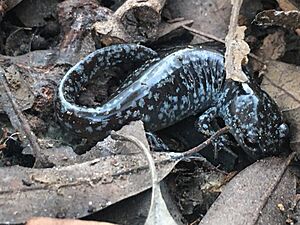Mabee's salamander facts for kids
Quick facts for kids Mabee's salamander |
|
|---|---|
 |
|
| Conservation status | |
| Scientific classification |
The Mabee's salamander (scientific name: Ambystoma mabeei) is a cool type of mole salamander. These salamanders live in wet, swampy areas, like pine forests, open fields, and woods with lots of trees. They often dig burrows close to ponds where they lay their eggs.
Their eggs are usually stuck to plants underwater or to stuff at the bottom of ponds. These ponds are often a bit acidic and don't have fish. Young salamanders, called larvae, grow up in these ponds. We don't know exactly how far they travel on land, but it's probably more than 150 meters (about 500 feet).
Contents
Where Mabee's Salamanders Live
Mabee's salamanders are found in the southeastern United States. You can find them along the Atlantic Coastal Plain. Their home range includes states like Virginia, Georgia, North Carolina, and South Carolina.
While we don't know the exact number of adult salamanders, scientists think there are at least 10,000 of them. They like to live in open fields, pine forests, and woodlands with different kinds of trees.
Mabee's Salamander Behavior and Diet
Young and adult Mabee's salamanders spend most of their time on land. They often hide in shallow tunnels under fallen leaves and plants. They probably eat small insects and earthworms.
Baby salamanders, called larvae, live in the water. They eat tiny water creatures like zooplankton and other small bugs that live in ponds.
Life Cycle and Reproduction
Mabee's salamanders breed in the late winter and early spring. The female salamander lays her eggs one by one, or in small groups. She attaches them to plants at the bottom of the pond.
The eggs usually hatch in about two weeks. The larvae grow in the water and are ready to change into adult salamanders by May. This change, where they go from living in water to living on land, is called metamorphosis.
Conservation Status
The IUCN (International Union for Conservation of Nature) is a group that checks on animals around the world. They list the Mabee's salamander as "Least Concern". This means they are not currently in danger of disappearing.
However, there are still some challenges for these salamanders. Their homes, like grasslands and woodlands, are sometimes damaged. Also, the ponds and temporary water bodies where they breed can be drained. Even though their numbers seem to be going down, it's not happening fast enough for them to be listed as more threatened right now.


